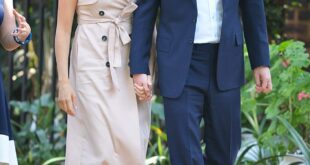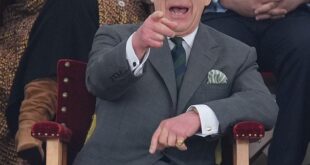Royal Mail’s machines are not always able to scan new barcodes correctly, an executive at the firm has reportedly said.
GB News has been calling for Royal Mail to investigate its processes after exclusively revealing Royal Mail had admitted branding a genuine stamp as “counterfeit”, and incorrectly charging the recipient £5.
After Catherine Prest contacted her MP Sir Paul Beresford about the matter, Royal Mail rechecked the stamp and told the customer they were sorry for mistakenly calling a genuine stamp “counterfeit”.
The company offered a £5 cheque to cover the cost of the incorrect penalty fee and said an investigation by senior colleagues at Royal Mail Revenue and Protection was underway to “ascertain why this has happened, and what can be done to prevent it from happening again”.were investigating.
Our investigation in January found dozens and dozens of Britons were being charged £5 for stamps deemed “counterfeit”, despite the senders insisting they had bought them from reputable retailers such as Post Office.
A senior executive has now said they know of a “handful” of cases where members of the public have been incorrectly surcharged, according to reports.
The source said the final decision was always made by a human expert who “really rarely” makes the wrong decision.
Have you been affected by this issue? Get in touch by emailing money@gbnews.uk.
A spokesperson from the Chinese Embassy in London said the suggestion was “totally ridiculous, absurd and ill-intentional”.
They added: “If this case really happened, (the) first thing to do is to have (a) thorough investigation over the internal supply chain, instead of pursuing the attention of (the) media.”
GB News has continued to urge Royal Mail to investigate after finding examples of people from across the UK who have said they bought their stamps from reputable sources, such as Post Office and well-known supermarkets.
We have also seen examples of one stamp in the book being deemed counterfeit, while others from the same book were not flagged as problematic.
Royal Mail said that, based on images they received of one of these booklets and the “counterfeit” stamp, all of the stamps in the book and on the envelope were found to be “counterfeit”.
A Royal Mail spokesperson added: “There is no postmark cancellation on the test letter sent by the customer who purchased the stamps. This would indicate it was processed manually and our machines did not therefore identify it as counterfeit.
“The process for manual processing relies upon human intervention to identify a counterfeit stamp and on this occasion, it was not picked up by our people – this is due in part to the high quality of some counterfeits in circulation.”
Another affected customer, Natasha, 49, was shocked to find her loved one was hit with the “counterfeit” surcharge after sending a letter with a stamp bought at Post Office.
She told GB News: “Given that I know the stamp I used was purchased from Post Office itself and was a book of multiple stamps, I find it quite strange to wonder how one counterfeit stamp found its way into a book of authentic stamps. The others all got used and delivered completely ok.”
When we contacted Royal Mail, the firm said Natasha’s stamp had been checked and confirmed as counterfeit.
Post Office subsequently apologised to Natasha and offered her a £25 cash voucher as a gesture of goodwill.
The executive at Royal Mail told the Telegraph that once letters arrive at the mail centre, they go through the system and the barcode is read.
“If the barcode comes up as suspicious it is rejected and goes into a separate channel for further checks,” the source said.
“A revenue protection person will then inspect the item using specialist equipment. I know people are naturally suspicious of machines, it’s not all reliant on machines. The machine is the thing which flags the suspicion – it’s a multi-stage check.
“Sometimes we’ll say, ‘No the machine is being overly sensitive, actually that stamp is fine’.”
The source defended the false positives being identified by the “sensitive” machines, saying it operates on a “better to be safe than sorry” system and that it isn’t the machine that decides whether a customer is surcharged.
They added: “I want people to have faith…[but] mistakes will happen, I don’t doubt it. But when they do we want to put it right. If we are told somebody has incorrectly labelled it as counterfeit we want to follow up whatever steps are necessary to make sure that doesn’t happen again.
GB News has contacted Royal Mail asking for comment.
Post Office has seen a rise in the number of complaints about “counterfeit” stamps bought from Post Offices, a freedom of information request by GB News has found.
Post Office received four complaints about this issue in 2018, increasing to 70 between January 1, 2023 to March 1 this year.
A Post Office spokesperson said: “Over the past 15 months we have recorded 70 complaints concerning counterfeit stamps. After explaining the wide range of places that stamps can be purchased and the need for a receipt in order for us to start making enquiries, we have found that many customers have been unable to recall exactly where they purchased a stamp.
“That said, we will always make enquiries as and when a customer shares an itemised receipt along with a high-quality image of the stamp or stamps is sent to us so that this can be looked into further. Only then can we undertake enquiries and do our best to resolve the issue for our customers.”
LATEST DEVELOPMENTS:
Royal Mail has admitted incorrectly charging a customer £5 for the genuine first class stamp (right) after calling it “counterfeit”, GB News has revealed
PA | GB NEWS
A Royal Mail spokesperson said: “Royal Mail takes the illegal production of counterfeit stamps seriously. The introduction of unique barcodes and added security features has made it harder for fraudsters to replicate stamps, and as a result the number of counterfeit stamps has reduced by around 90 per cent.
“We have a robust, multistage process in place for assessing suspect stamps. Our letter processing machines scan, identify and extract counterfeit stamps before they are individually inspected by a skilled member of the team using specialist equipment before any stamp is marked as counterfeit or pre-used.”
A Post Office spokesperson said: “Any allegation that fake stamps have been purchased at a Post Office is extremely serious.
“The implication of such an allegation is that one of our Postmasters, or a member of their staff, has obtained fake stamps and have chosen to sell them to customers rather than selling legitimate stamps that have come from Royal Mail’s secure printers.
“Post Office receives it stamps from Royal Mail’s secure printers. They are delivered to our warehouse.
“Individual Post Offices then receive their stamps from the Post Office at the same time as cash is delivered to their branch – both the stamps and cash is transported to branches in our secure vans. Our advice to customers is to always purchase their stamps from a Post Office counter within a branch.”
Source link


